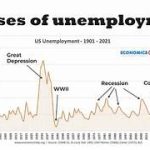Unemployment’s Effect on Social Welfare Programs
Unemployment is not just an individual financial crisis; it has far-reaching effects on society as a whole. Among the most significant impacts is the strain it places on social welfare programs designed to assist those in need. Social welfare programs are safety nets that help provide for individuals and families when they face economic hardships, such as unemployment. However, the relationship between unemployment and social welfare is complex, with varying consequences for both the programs themselves and the broader economy. This article explores how unemployment affects social welfare programs, the challenges it presents, and the strategies that can be implemented to alleviate some of the pressure on these systems.
The Role of Social Welfare Programs
Before diving into the effects of unemployment on these programs, it’s important to first understand what social welfare programs are and their purpose. Social welfare programs aim to ensure that individuals and families maintain a basic standard of living when faced with hardship. These programs vary from country to country but typically include:
- Unemployment Insurance (UI): Temporary financial assistance for workers who lose their jobs through no fault of their own.
- Food Assistance: Programs like the Supplemental Nutrition Assistance Program (SNAP) in the U.S., which help low-income individuals and families afford nutritious food.
- Healthcare Subsidies: Programs like Medicaid or public health insurance that ensure people without jobs can still access healthcare.
- Housing Assistance: Government-provided financial support for people struggling to pay rent or buy homes.
These programs are designed to prevent individuals from falling into extreme poverty and help maintain social stability. However, when unemployment rates rise, the demand for these programs increases, and their sustainability comes into question.
The Strain on Social Welfare Systems
One of the most immediate effects of rising unemployment is the increased demand for social welfare programs. When people lose their jobs, they often struggle to cover basic expenses such as food, rent, and healthcare. As more individuals rely on social safety nets, the government’s resources become stretched thin, particularly during periods of high unemployment.
- Increased Financial Pressure on the Government: High unemployment rates mean that the government must provide financial assistance to a larger portion of the population. In the case of unemployment insurance, for example, the number of claims typically increases as more workers lose their jobs. This leads to a higher demand for government spending, which can strain the national budget. Governments may have to allocate more funds to these programs, potentially diverting resources from other areas such as education, infrastructure, and healthcare. The increased demand for welfare can create budgetary imbalances, particularly if unemployment remains high for an extended period. Some countries may face difficult choices between cutting other services or borrowing more money to finance social welfare programs.
- Long-Term Sustainability: Unemployment benefits and other social assistance programs are often funded through taxes, which are collected from employed individuals and businesses. As unemployment rises, fewer people are paying taxes, while more individuals are receiving benefits. This imbalance can make social welfare programs less sustainable in the long term, particularly if unemployment persists for an extended period or if it spikes unexpectedly, such as in the case of a recession or global crisis like the COVID-19 pandemic. If the tax revenue decreases significantly, the government may struggle to maintain the level of support that is needed to prevent widespread poverty. This could lead to cuts in benefits or eligibility restrictions, potentially exacerbating the economic hardships faced by unemployed individuals.
- Increased Demand for Other Welfare Services: Unemployment doesn’t only affect unemployment insurance programs. It can also create increased demand for other social services. For example, unemployed individuals are more likely to seek food assistance, healthcare subsidies, and housing support. As a result, social service agencies may experience an influx of requests for help. This increased demand often leads to longer waiting times, reduced service quality, and, in some cases, the inability to meet all the needs of the unemployed. In areas with high unemployment rates, the pressure on local governments and nonprofit organizations can become overwhelming, making it difficult to provide sufficient assistance to all those who need it.
- Social Welfare and Poverty Cycle: A prolonged unemployment crisis can create a cycle of poverty. Long-term unemployment often leads to increased reliance on social welfare programs, which may not provide enough support to help individuals escape poverty. In some cases, the financial assistance provided may be too minimal to cover all living expenses, leaving individuals in a constant state of financial instability. This cycle can be especially damaging when unemployment becomes structural, meaning that the factors causing unemployment are long-term and not just a temporary economic downturn. Additionally, extended periods of unemployment can lead to skills deterioration, making it even harder for individuals to re-enter the workforce. As a result, they may become increasingly dependent on social welfare programs for survival, perpetuating a state of poverty and reliance on government assistance.
The Impact on Families and Communities
The effects of rising unemployment are not limited to individuals; they extend to families and communities as well. The increased reliance on social welfare programs to provide basic necessities can create emotional and social strain.
- Family Stress: Unemployment often leads to significant stress within families. In households where a primary breadwinner loses their job, the emotional burden of unemployment can affect family dynamics. Tension between partners, concerns about meeting basic needs, and uncertainty about the future can all contribute to a challenging family environment. This stress can be particularly difficult for children, who may experience negative effects on their academic performance, mental health, and overall well-being due to the instability at home. Families that rely heavily on social welfare programs may also experience a loss of dignity and self-esteem. Relying on welfare assistance can carry a social stigma, which may affect individuals’ sense of personal achievement and worth.
- Community Strain: Unemployment can also take a toll on communities. When unemployment rates are high, local businesses suffer from reduced consumer spending, which can lead to more business closures and additional job losses. This can result in a vicious cycle of economic decline, where each job loss contributes to a further weakening of the local economy. Furthermore, communities that have a large number of individuals relying on social welfare programs may see a rise in poverty and social instability. This can lead to increased crime rates, social unrest, and a decline in overall quality of life. Nonprofit organizations, churches, and other local groups may face overwhelming demand for services, which can deplete resources and limit their ability to help the most vulnerable populations.
Government Responses to Mitigate the Effects
Governments have developed various strategies to address the strain that unemployment places on social welfare programs. Some of these strategies include:
- Temporary Expansions of Welfare Programs: During times of high unemployment, governments often introduce temporary measures to expand welfare programs. For example, during the COVID-19 pandemic, many countries expanded unemployment benefits and introduced new forms of financial support to help individuals who were temporarily out of work. These measures are designed to provide immediate relief to those affected by unemployment.
- Job Creation Programs: Governments may also invest in job creation programs to stimulate economic growth and reduce unemployment. These programs can range from infrastructure projects to initiatives aimed at supporting small businesses or training workers for high-demand sectors.
- Workforce Development and Retraining: In response to rising unemployment, some governments invest in workforce development and retraining programs. These programs aim to help individuals gain new skills and qualifications that are in demand in the labor market, thereby improving their chances of finding employment.
- Universal Basic Income (UBI): Some policymakers have suggested implementing a Universal Basic Income (UBI) as a way to provide a guaranteed income to all citizens, regardless of employment status. While this idea has its proponents, its feasibility and effectiveness in addressing unemployment’s impact on social welfare are still debated.
Conclusion
Unemployment has a significant impact on social welfare programs, straining government resources, and creating social and economic challenges. The increased demand for financial assistance, food support, healthcare, and housing services can push social safety nets to their limits, making it difficult for governments to sustain these programs. Additionally, the social and emotional toll on individuals, families, and communities can be profound.
Addressing the challenges posed by unemployment requires a multi-faceted approach, including temporary expansions of welfare programs, job creation, workforce retraining, and investment in social services. Governments must carefully balance the needs of the unemployed with the long-term sustainability of social welfare programs. Ultimately, it is essential to develop strategies that support the unemployed while helping them re-enter the workforce, ensuring both individual and societal well-being.


